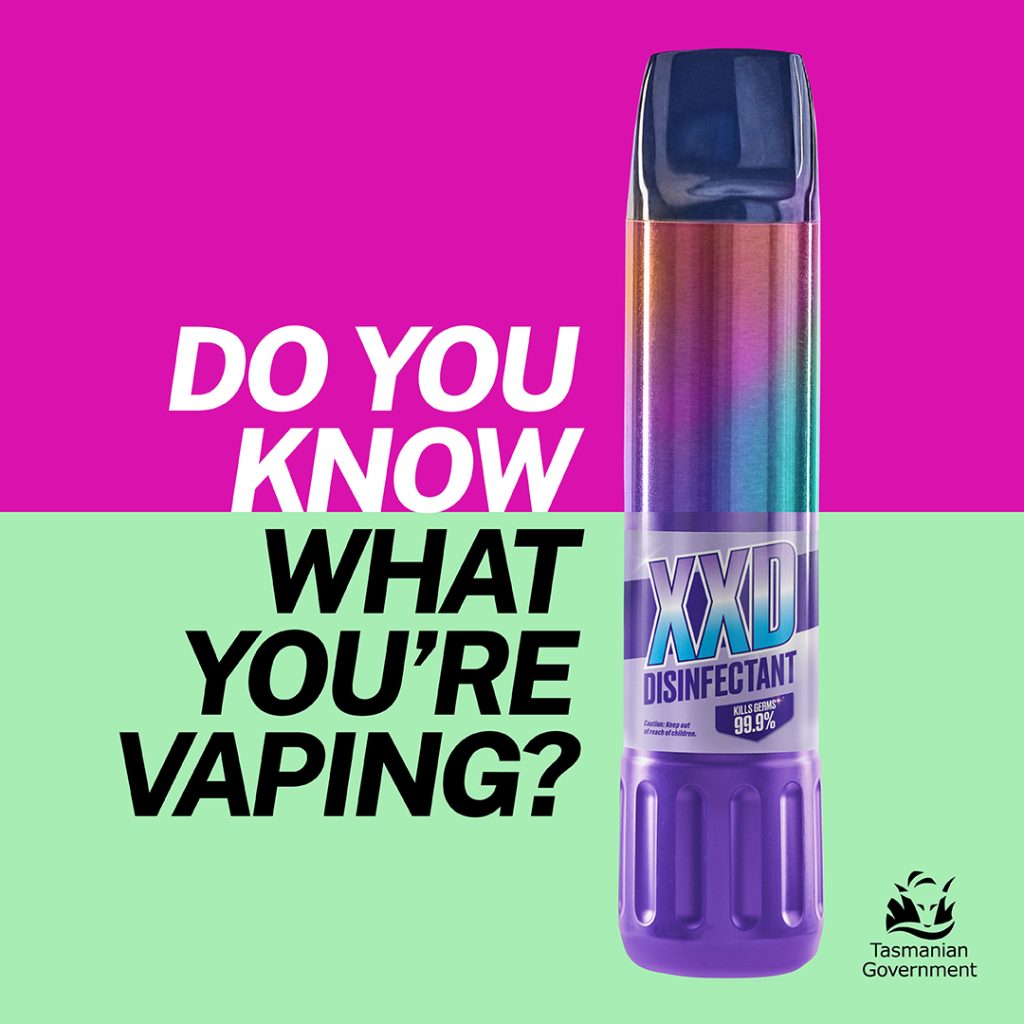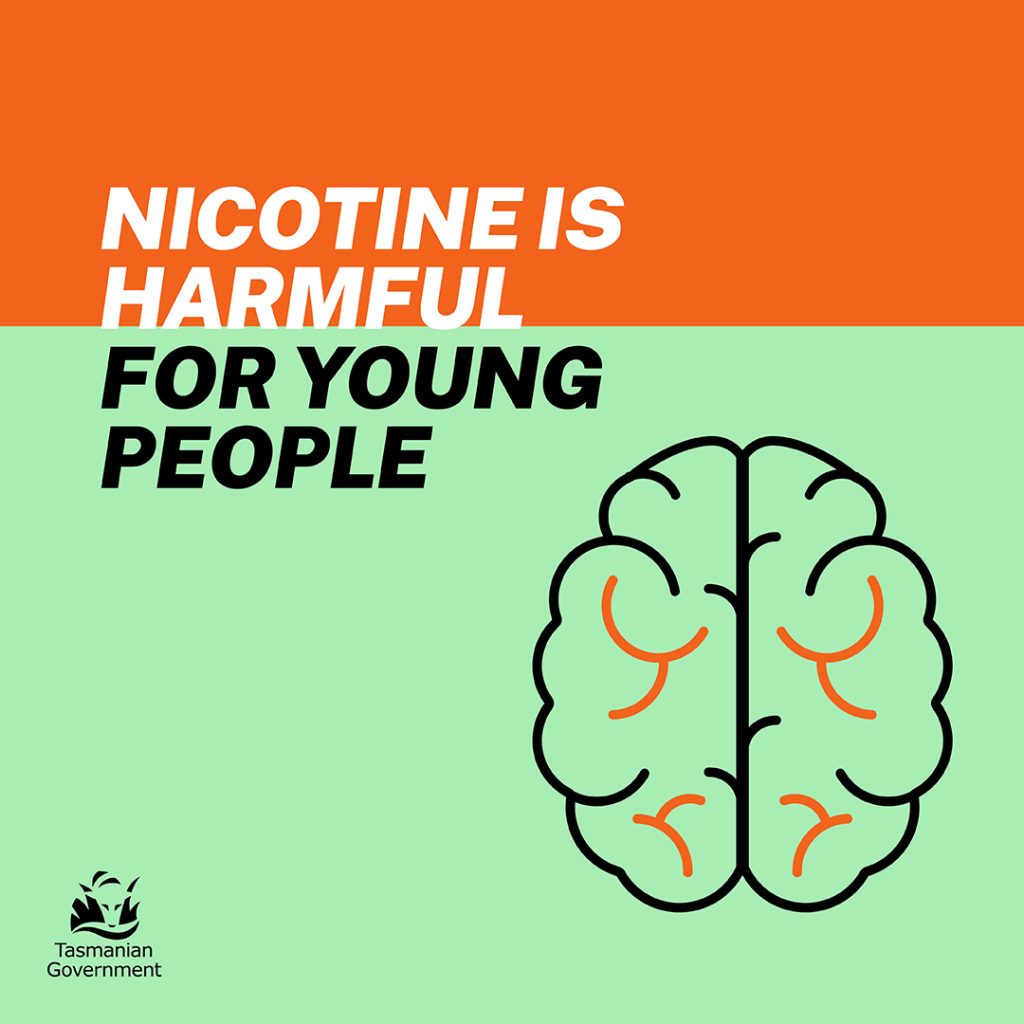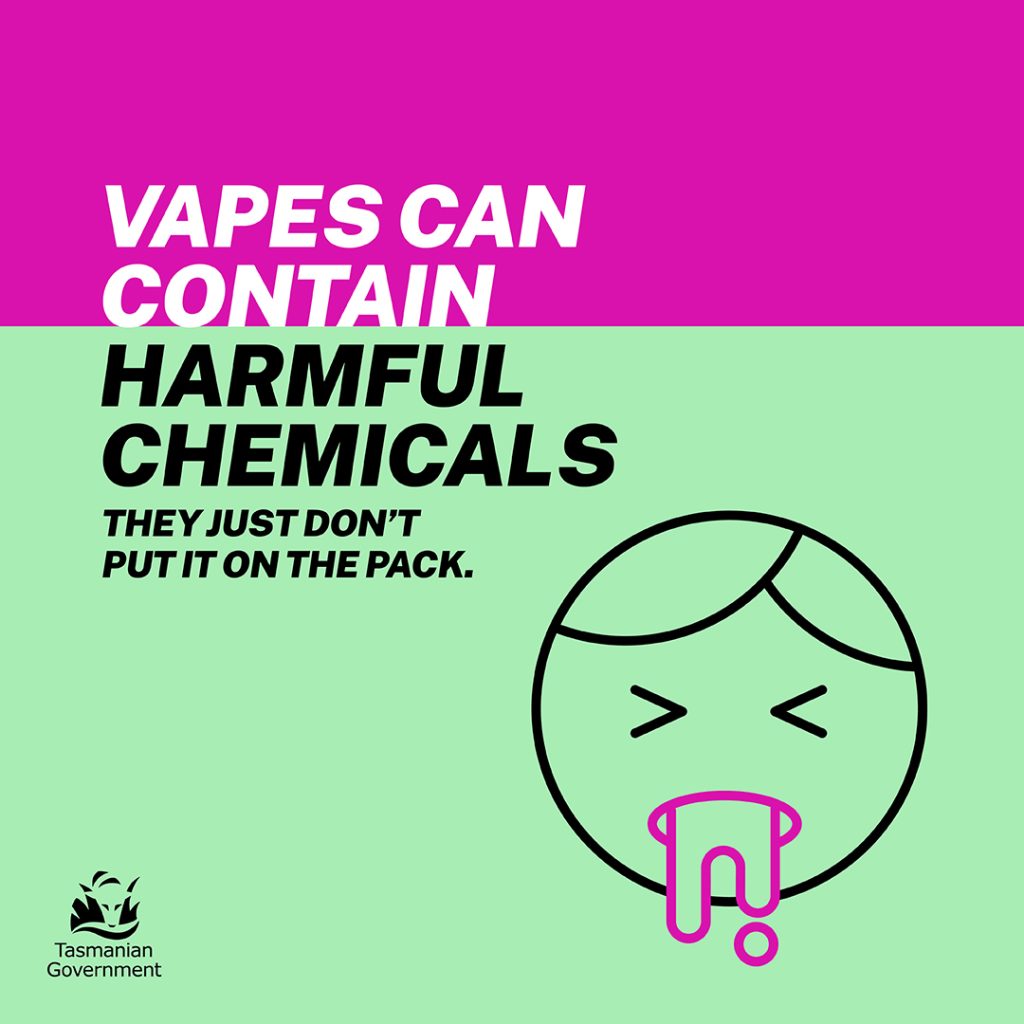
Vaping is similar to smoking cigarettes, but instead of burning tobacco it heats a liquid.
Are you a parent, carer or teacher worried about young people vaping? Or a young person wanting information or trying to cut back?
Here you can find resources and support.
Key facts
- Vaping is not better for you than smoking.
- Vape aerosol is not water vapour. It has a lot of harmful ingredients.
- Most vapes contain addictive nicotine – and are often wrongly labelled as nicotine-free.
- For a young person, nicotine addiction can make it harder to concentrate and learn.
- Support is available to help you quit/reduce your usage and to help you deal with peer pressure.
- Tasmanian schools are designated smoke and vape free sites.
- Vapes can come in many shapes and sizes.
- If you are a teacher, parent or carer, there are lots of free resources to support you to talk to young people about vaping.
Find support
- Practical tips by Quit Tasmania to quit vaping.
- Personalised support with Quit Tasmania’s experts
- Culturally safe support through Aboriginal Quitline
- In our schools, students can access school health nurses. Nurses can help with referrals, access to nicotine replacement therapy, managing nicotine dependence and cessation support. Talk with your school to book an appointment.
- For mental health support, visit: headspace
- Talk or chat online to a counsellor – Beyond Blue
Frequently asked questions
General information – what is it and what’s in it?

What is vaping?
Electronic cigarettes (also called e-cigarettes or vapes) are similar to smoking cigarettes – but without the use of tobacco.
Vapes are battery-operated devices that heat a liquid (e-liquid or “juice”) until it turns into an aerosol. The aerosol is then inhaled and this is called “vaping”. People wrongly think the aerosol in vaping is only water vapour, but it actually contains dangerous chemicals.
The biggest misunderstanding about vaping is that it is harmless compared to smoking cigarettes. This is not true. Vapes are not safe.

What do vapes look and smell like?
Vapes come in many shapes. They can look like highlighters, pens or USB memory sticks.
Their vapour often smells sweet.

What is in a vape?
Vape aerosol is not water vapour.
There are no quality or safety standards for vapes or vaping liquids.
The main ingredient in vapes is propylene glycol, vegetable glycerine or glycerol. But you’ll also find many harmful chemicals and heavy metals.
The packaging is often wrongly labelled and doesn’t list all the ingredients.
Some common chemicals in vapes are:
- acetone found in nail polish remover
- acrolein found in weed killer
- 2-cholorophenol found in cleaning products and bug spray
- flavouring chemicals like diacetyl, which is linked to serious lung disease
Heavy metals found in vapes:
- nickel
- tin
- lead
Some vaping liquids also contain illegal substances.
Vapes often have nicotine, the same highly addictive substance found in tobacco cigarettes. Sometimes vapes have even more nicotine than cigarettes, even if they’re labelled as not having any. The nicotine in 1 vape can equal 50 cigarettes, or even more.
Vapes are often available in different flavours which can be appealing to young people and children. While some chemicals in vapes are also used in food production and are generally considered safe when eaten, this does not mean they are safe when they are inhaled directly into the lungs.
Addiction

Is it addictive?
Yes, vapes with nicotine are very addictive. And many vapes have nicotine in them even when the label says they don’t!
If you are addicted to nicotine, you might:
- find it difficult to concentrate.
- get nervous, irritable, angry and anxious.
- have to leave class to vape.
- need to have a vape on you all the time.
- get a new one as soon as it runs out.
But the good news is that you don’t have to be addicted forever! You can quit vaping and beat an addiction to nicotine. There are lots of things you can do to stop vaping and join the majority of Tasmanian kids and young people who don’t vape. You can find some of these at the bottom of the page under Useful Resources for Young People. To get support, check out the resources at the top of the page.

Do people who vape go onto use tobacco cigarettes?
Most adults who smoke cigarettes became addicted to nicotine as teenagers.
Nicotine is highly addictive and research suggests that young people can become more easily addicted to nicotine than adults.
Research shows young people are three times as likely to start smoking if they vape.
Impacts – short- and long-term health risks and environmental impact

What are short-term impacts?
- make you feel sick and vomit
- irritate your mouth and throat
- cause shortness of breath
- cause chest pain and make your heart race
- weaken your immune system
- increase risk of developing asthma
- worsen stress and anxiety
What is nicotine poisoning?
Because labels are often wrong, vapes give you uncontrolled levels of nicotine. This can be dangerous.
Too much nicotine from vapes can give you nicotine poisoning. Symptoms are:
- sweating
- heart racing
- shaking
- stomach cramps or vomiting
- changes in breathing
- feeling agitated or confused
Direct exposure to e-liquids with nicotine can lead to poisoning. In some people, this can be severe and may even cause death.
If you think you or someone else might have nicotine poisoning call 000 and ask for an ambulance.
You can also call the poisons hotline on 13 11 26. They can give you advice on what to do.

What do you think it is doing to your lungs?
If you vape, there is a higher risk of getting lung infections and diseases and of developing asthma.
What are other long-term risks of vaping for young people?
A young person’s brain develops until around the age of 25. Exposing your developing brain to nicotine addiction can impact memory, attention and learning. Even vapes that do not contain nicotine are still not safe and can have negative, long-lasting health outcomes for young people because of the chemicals and heavy metals they contain.
What are environmental impacts?
Vapes cause a lot of waste because they are made of plastic and toxic parts.
What does the law say?
To protect young people, e-cigarettes are treated the same as tobacco cigarettes under Tasmanian law. This means:
- a person under 18 cannot use, possess or buy vapes
- vapes cannot be used in public areas that are smoke free – this includes:
- bus shelters
- bus and pedestrian malls
- within 3 meters of an entry or exit to a public building
- bars and restaurants
- workplaces
- cars with a child in it
- certain public events
It’s also illegal for anyone (even adults) to use, buy or sell nicotine containing e-cigarettes in Australia without a prescription.
What to do if a young person you know vapes and you’re worried?
Talk to them and listen to their views and their ‘why’. Many young people have withdrawal symptoms without vaping and some use it as a coping mechanism – try to be engaging and understanding. Tell them about your worries and the negative impacts. Remind them that withdrawal symptoms are a sign that the body is repairing itself and there are ways to deal with recovery symptoms. Help them get support.
Useful resources
For teachers
These resources will help you understand the impact of vaping on young people and have conversations with them:
- free downloadable posters and factsheets for teachers and schools from the Department of Health
- free educational resources by Lung Foundation Australia, including factsheets and an e-learning activity
- Quit Tasmania’s factsheets and posters on the health impacts of vaping for young people
- Quit Tasmania’s resources on support to quit smoking and vaping
- videos on vaping devices and how they work
- ABC News published a story about the ‘suite of chemicals’ in the liquids used in vapes
- resources to guide you on organising a Student Voice Group on vaping at your school:
One of the five propositions of the Australian Curriculum is developing the health literacy of children and young people.
This involves building student’s ability to analyse, interpret and apply health information. This allows them to make informed decisions about their health.
The Health and Physical Education (HPE) curriculum provides an ideal platform for delivering this education, including addressing the risks associated with vaping.
By integrating this topic into school curriculum, students can be empowered to make healthy choices, reduce the prevalence of vaping among young people and promote a healthier future for our communities. Read the Vaping- Possible links to V9.0 Australian Curriculum for Teachers (PDF, 136KB) (link only accessible to DECYP staff)
As smoke-free areas are also vape-free areas, the Department of Health has developed new signs, that reflect this. These can be downloaded from the Department of Health website.

For parents and carers
These resources will help you understand the impacts of vaping on young people, and support you in having conversations with your children:
- Department for Education, Children and Young People fact sheet – Vaping: Information and advice for parents and carers (PDF, 220KB)
- downloadable Do you know what you’re vaping? fact sheets and posters for parents and carers from the Department of Health
- facts around vaping and a short e-learning activity by Lung Foundation Australia
- information on vapes as well as support to quit by Quit Tasmania
- videos on vaping devices and how they work
- ABC News published a story about the ‘suite of chemicals’ in the liquids used in vapes, some at ‘dangerously high’ levels
- things you can do:
- Set a good example by being tobacco or vape free. Research shows that young people are less likely to smoke or vape if their parents or carers do not smoke or vape.
- If you have found quitting difficult and still smoke or vape, share your experiences with your child.
- The best way to protect your children is to never smoke or vape in the house or other places where there may be children nearby.
- Smoking or vaping in a car when children are present is illegal. Passive exposure to e-cigarette aerosol can be damaging for children and young people.
- Report those who are selling vapes to minors or selling vapes containing nicotine
- Whether you suspect your child is vaping or not, take the time to talk to them about it and help them understand all of the risks. It is never too late to have the conversation.
- ABC podcast gives practical tips on how to talk to your child about vaping.
- Other tips on talking with your children about vaping (and alcohol and drug use more generally):
- try to start the conversation with your child in a relaxed easy-going way, perhaps taking the cue from around you, a note from school, a news story about vaping, or seeing people vaping on the street
- be approachable and unshockable – listen to their ideas even if you don’t agree
- try not to interrupt or react in ways that stop discussion – they might worry about telling you things you need to hear
- show them where to get accurate information from reliable sources
- help them think about risks to their health and wellbeing – but don’t exaggerate.
- encourage their involvement in a range of activities, sports and hobbies.
- If you think your child is vaping, here are some tips to approach this topic:
- Don’t react immediately. Give yourself time to calm down and think through what’s happening.
- The best way to find out what’s happening is to ask them – that is, by talking rather than by ‘detection’. Don’t go behind their back and search for vapes. The loss of trust will be greater than the benefit of anything you might find out.
- Try to avoid strong reactions and big arguments that could harm your relationship.
- A respectful tone and body language can go a long way.
- Tell them you’re concerned about their wellbeing and you think they might be vaping. Let them know you want to help.
- Avoid judging or lecturing – listen to their point of view and keep it a two-way conversation.
- Give them a chance to tell you what’s happening without interrupting or lecturing. Find out how often and where they are vaping.
- Consider asking questions like: ‘What made you want to try?’ and ‘How did it make you feel?’
- Ask what they need and help them get support.
- Set a good example by being tobacco or vape free. Research shows that young people are less likely to smoke or vape if their parents or carers do not smoke or vape.

For young people
These resources will help you understand the impacts of vaping and support on quitting it:
- facts on vaping from Lung Foundation Australia
- sign up to a short eLearning activity on vaping and dealing with peer pressure
- benefits of being smoke- and vape-free:
- easier to play sport & do exercise
- more energy to do the things you love
- save money to buy the things you love
- lower chances of having a heart-attack or stroke
- protect your lungs
- some of the things you can do when you feel the urge to vape are:
- delay – most urges come and go in 3-5 minutes.
- drink water
- deep breaths
- distract – go for a walk, do something you enjoy
- discuss – talk to someone
- some tips on dealing with peer pressure:
- Say ‘no’ calmly and explain why something’s not for you.
- Friends don’t have to agree on everything.
- Suggest something else you could do together instead.
- Don’t judge. Respecting someone else’s choice may help them respect yours.
- Be a leader – if you don’t vape, your friends might join you.
- Pursue your own interests. Hang out with people who like doing the same stuff you do.
- If you want an example of how to talk to say no to your friends, check out this video by kids helpline.
- downloadable Do you know what you’re vaping factsheets and posters from the Department of Health
- to get support, check out the resources at the top of the page.

